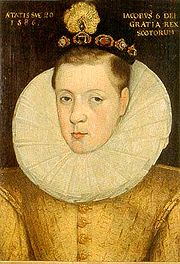
Some Reulis and Cautelis to be observit and eschewit in Scottis poesie
Encyclopedia

Scots language
Scots is the Germanic language variety spoken in Lowland Scotland and parts of Ulster . It is sometimes called Lowland Scots to distinguish it from Scottish Gaelic, the Celtic language variety spoken in most of the western Highlands and in the Hebrides.Since there are no universally accepted...
, also called The Essayes of a Prentise in the Divine Art of Poesie, written by the 19-year old James VI of Scotland (later also James I of England) and first published in Edinburgh
Edinburgh
Edinburgh is the capital city of Scotland, the second largest city in Scotland, and the eighth most populous in the United Kingdom. The City of Edinburgh Council governs one of Scotland's 32 local government council areas. The council area includes urban Edinburgh and a rural area...
. Its original purpose was to describe and propose the ideal standard for poets writing in the Scottish tradition
Scottish literature
Scottish literature is literature written in Scotland or by Scottish writers. It includes literature written in English, Scottish Gaelic, Scots, Brythonic, French, Latin and any other language in which a piece of literature was ever written within the boundaries of modern Scotland.The earliest...
, a tradition which includes James' direct ancestor, James I
James I of Scotland
James I, King of Scots , was the son of Robert III and Annabella Drummond. He was probably born in late July 1394 in Dunfermline as youngest of three sons...
(1394-1437).
James VI, as a young poet-king, was both the head and patron of the Castalian Band
Castalian Band
The Castalian Band was a group of Scottish Jacobean poets, or makars, which flourished between the 1580s and early 1590s in the court of James VI and was consciously modelled on the French example of the Pléiade. Its name is derived from the classical term Castalian Spring, a symbol for poetic...
, a fairly loose circle of court poets which he both established and composed alongside with as peers in the 1580s and early 1590s. It is certain that the treatise was intended to set the aesthetic standard for the writing he wished to advocate. The Castalian poets included Alexander Montgomerie
Alexander Montgomerie
Alexander Montgomerie , Scottish Jacobean courtier and poet, or makar, born in Ayrshire. He was one of the principal members of the Castalian Band, a circle of poets in the court of James VI in the 1580s which included the king himself. Montgomerie was for a time in favour as one of the king's...
, William Fowler, William Alexander, John Stewart
John Stewart of Baldynneis
John Stewart of Baldynneis, , was a writer and courtier at the Scottish Court. he was one of the Castalian Band grouped around James VI....
and Alexander Hume
Alexander Hume
Alexander Hume was a Scottish poet.The son of Patrick, 5th Lord Polwarth, he was educated at the University of St. Andrews and on the Continent. He was originally destined for the law, but devoted himself to the service of the church, and became minister of Logie in Stirlingshire...
and others variously. James' patronage as Scottish king also attracted poets from furth of Scotland, such as Thomas Hudson
Thomas Hudson (poet)
Thomas Hudson, was a musician and poet from the north of England present at the Scottish court of King James VI at the end of the 16th century...
.
Like most of James' writing, Reulis and Cautelis (Rules and Cautions) was written in his first language, Middle Scots
Middle Scots
Middle Scots was the Anglic language of Lowland Scotland in the period from 1450 to 1700. By the end of the 13th century its phonology, orthography, accidence, syntax and vocabulary had diverged markedly from Early Scots, which was virtually indistinguishable from early Northumbrian Middle English...
. Because of its subject, it was one of the few manuscripts by the King that was not anglicised by his London publisher Thomas Waldegrave for publication in England.
External links
- http://books.google.co.uk/books?id=43jmYB_dxD8C&pg=PA23&lpg=PA23&dq=Some+Reulis+and+Cautelis+to+be+observit+and+eschewit+in+Scottis+poesie&source=bl&ots=JUfrHLrz6V&sig=q_7kKmAl0Y4VtL-iEo63wEqYNvE&hl=en&ei=3wxPTNfkDtOQjAem7-myBw&sa=X&oi=book_result&ct=result&resnum=2&ved=0CBgQ6AEwAQ#v=onepage&q=Some%20Reulis%20and%20Cautelis%20to%20be%20observit%20and%20eschewit%20in%20Scottis%20poesie&f=falsePreview of the modern edition of Reulis and Cautelis]

